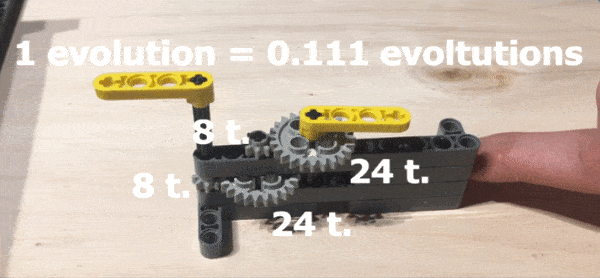With this package you can control your BrickPi3 with nodejs.
This package has the same interface as the python library and was copied 1:1 with sligth language adjustments (bitwise operators are a bit different and the return values are promises). So just look at their examples (https://github.com/DexterInd/BrickPi3/tree/master/Software/Python/Examples) to see, how you can archive different tasks. Just remember, that you get promises back from most of the methods.
If you find any bugs, please open an issue or submit a pull request. I couldn't test everything, because I only have ev3 large motors. So I need your help to know if everything else works :)
npm install --save brickpi3const brickpi3 = require('brickpi3');
(async () => {
try {
let BP = new brickpi3.BrickPi3();
//Make sure to stop and free all motors and sensors when the programm exits
brickpi3.utils.resetAllWhenFinished(BP);
//Resetting offset position of motor A to 0
let encoder = await BP.get_motor_encoder(BP.PORT_A);
await BP.offset_motor_encoder(BP.PORT_A, encoder);
await BP.set_motor_power(BP.PORT_A, 10);
} catch (err) {
console.log(err);
}
})();When you need to find the extreme offsets of the motor (f.e. an arm can only get from point a to point b but not beyond), there is a helper function available like explained in this video: https://youtu.be/d0bghBZZMUg?t=1m35s
const brickpi3 = require('brickpi3');
(async () => {
try {
let BP = new brickpi3.BrickPi3();
brickpi3.utils.resetAllWhenFinished(BP);
await brickpi3.utils.resetMotorEncoder(BP, BP.PORT_A, brickpi3.utils.RESET_MOTOR_LIMIT.MIDPOINT_LIMIT);
await BP.set_motor_position(BP.PORT_A, 0);
console.log("Motor should now be in the middle of its two extremes");
} catch (err) {
console.log(err);
}
})();For easier working with motors and sensors, you can get an instance of each of them and then access their methods:
const brickpi3 = require('brickpi3');
(async () => {
try {
let BP = new brickpi3.BrickPi3();
brickpi3.utils.resetAllWhenFinished(BP);
//Get the instance of one motor and sensor
let motor = brickpi3.utils.getMotor(BP, BP.PORT_A);
//getSensor has an optional third parameter which allows to overwrite the default configuration time limit
let sensor = brickpi3.utils.getSensor(BP, BP.PORT_2);
//First set the type of the sensor
await sensor.setType(BP.SENSOR_TYPE.EV3_TOUCH);
//You can also change the default configuration time limit (3000ms) for the sensor configuration after initialization
sensor.setConfigurationTimeLimit(4000);
//Reset the motors encoder to 0
await motor.resetEncoder();
//Rotates the motor one revolution - will resolve only when finished
await motor.setPosition(360);
//Powers on the motor until the callback function is true (good to use with sensors f.e.)
await motor.setPower(50, async () => {
return await sensor.getValue() === 1;
});
} catch (err) {
console.log(err);
}
})();If you want to calculate, what gear ratio some connected gears have, there is also a helper:
const brickpi3 = require('brickpi3');
//A 8-teeth-gear drives a 24-teeth-gear, which is connected to another 8-teeth-gear, which drives another 24-teeth-gear
console.log(new brickpi3.utils.Gear(8).drive(24).connect(8).drive(24).getFactor());
// => 0.111 (so if you rotate the initial 8-teeth-gear one evolution, the last 24-teeth-gear will rotate 0.111 rounds in the same direction)If you have multiple brickPi3's, you can stack them and control even more motors/sensors with a single raspberry pi.
First attach each brickPi separatly and execute the following script. You need to write down the id of each brickPi.
const brickpi3 = require('brickpi3');
(async () => {
try {
let BP = new brickpi3.BrickPi3();
console.log(await BP.get_id());
} catch (err) {
console.log(err);
}
})();Then you can set the address for each of your brickPi's in the initializing part and access the four sensors and motors with each brickPi object instance.
const brickpi3 = require('brickpi3');
(async () => {
try {
await brickpi3.set_address(1, 'A778704A514D355934202020FF110722');
await brickpi3.set_address(2, 'DF9E6AC3514D355934202020FF112718');
const BP1 = new brickpi3.BrickPi3(1);
const BP2 = new brickpi3.BrickPi3(2);
brickpi3.utils.resetAllWhenFinished(BP1);
brickpi3.utils.resetAllWhenFinished(BP2);
const motor1 = brickpi3.utils.getMotor(BP1, BP1.PORT_A);
const motor2 = brickpi3.utils.getMotor(BP2, BP2.PORT_A);
//Reset Motor A offset of your first brickPi
await motor1.resetEncoder();
//Reset Motor A offset of your second brickPi
await motor2.resetEncoder();
//Let the motor A of your first brickPi turn constantly
await motor1.setPower(10);
//Let the motor A of your second brickPi rotate by 45° every two seconds.
let target = 0;
const moveOn = async () => {
target = target + 45;
await motor2.setPosition(target);
setTimeout(moveOn, 2000);
};
moveOn();
} catch(err) {
console.log(err);
}
})();Thanks to Sumit Kumar (http://twitter.com/tweetsofsumit) for providing an example on how to communicate with the brickPi3 in nodejs on his repository.
